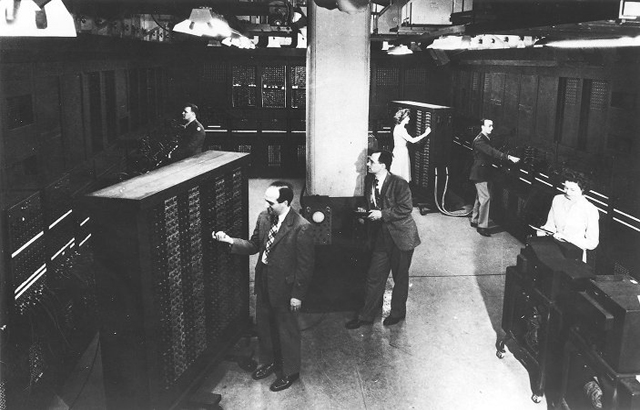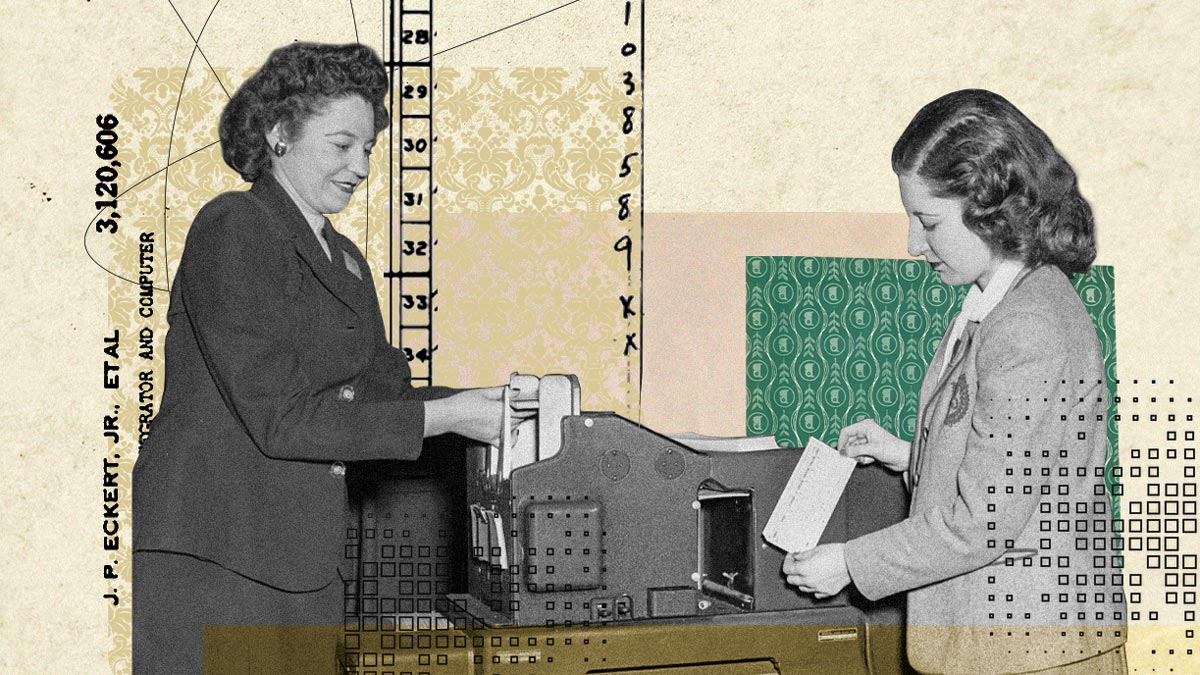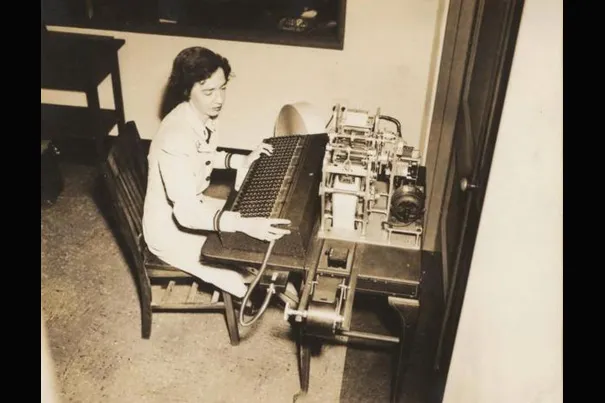In 1945, six women pulled off a computing miracle.
They programmed the world’s first computer—with no manuals, no training.
Then, a SINGLE assumption erased them from tech history for decades.
The story of how ONE photo nearly deleted computing’s female founders: 🧵
They programmed the world’s first computer—with no manuals, no training.
Then, a SINGLE assumption erased them from tech history for decades.
The story of how ONE photo nearly deleted computing’s female founders: 🧵

Kathy Kleiman, a young programmer, found old photos of women standing beside ENIAC—the first general-purpose computer.
When she asked who they were, curators said: “Probably just models”...
But Kleiman had a feeling they were something more:
When she asked who they were, curators said: “Probably just models”...
But Kleiman had a feeling they were something more:
They weren’t models.
They were the world’s first programmers.
First, they were hired as “human computers” to calculate missile trajectories during WWII.
Then chosen for a top-secret project unlike anything before:
They were the world’s first programmers.
First, they were hired as “human computers” to calculate missile trajectories during WWII.
Then chosen for a top-secret project unlike anything before:
Program ENIAC—a machine the world had never seen.
It was 8 feet tall, 80 feet long, and weighed over 60,000 pounds.
The engineers built the hardware...
But someone had to figure out how to make it do anything:
It was 8 feet tall, 80 feet long, and weighed over 60,000 pounds.
The engineers built the hardware...
But someone had to figure out how to make it do anything:

That job fell to six women:
Betty Holberton, Jean Bartik, Kay McNulty, Ruth Teitelbaum, Marlyn Meltzer, and Frances Spence.
But there was a problem...
They weren’t even allowed to touch the machine:
Betty Holberton, Jean Bartik, Kay McNulty, Ruth Teitelbaum, Marlyn Meltzer, and Frances Spence.
But there was a problem...
They weren’t even allowed to touch the machine:

Security restrictions kept them out of the ENIAC lab.
They had to write programs using only blueprints and logic diagrams.
No manuals. No programming languages...
So how do you code something no one’s ever coded before?
They had to write programs using only blueprints and logic diagrams.
No manuals. No programming languages...
So how do you code something no one’s ever coded before?

By inventing the process from scratch.
They built algorithms, flowcharts, and step-by-step routines—on paper.
Then, once granted access, they programmed ENIAC by physically rewiring it...
And that’s where things got even harder:
They built algorithms, flowcharts, and step-by-step routines—on paper.
Then, once granted access, they programmed ENIAC by physically rewiring it...
And that’s where things got even harder:
There was no keyboard.
Programming meant plugging thousands of cables into the right configuration—by hand.
It was almost impossible to program.
But they pulled it off anyway:
Programming meant plugging thousands of cables into the right configuration—by hand.
It was almost impossible to program.
But they pulled it off anyway:
On February 14, 1946, ENIAC was unveiled to the public.
It could do 5,000 calculations per second—1,000× faster than anything before.
It made headlines across the country...
But the real story was missing:
It could do 5,000 calculations per second—1,000× faster than anything before.
It made headlines across the country...
But the real story was missing:

The six women who made ENIAC work weren’t invited to the demo.
Photos of the machine appeared in newspapers...
But the people who programmed it? Not even named:
Photos of the machine appeared in newspapers...
But the people who programmed it? Not even named:
The credit went to the engineers who built the hardware.
Why were the programmers ignored?
Because back then, programming wasn’t seen as valuable work...
And that perception had lasting consequences:
Why were the programmers ignored?
Because back then, programming wasn’t seen as valuable work...
And that perception had lasting consequences:
Since women were doing it, people assumed it was secretarial—just “wiring” or “filing.”
Even though it required complex math and problem-solving...
Soon, the field of programming would be rewritten entirely:
Even though it required complex math and problem-solving...
Soon, the field of programming would be rewritten entirely:
As computing grew in importance, men took over.
The image of the “male genius coder” replaced the women who pioneered the field.
But what happened to the ENIAC six after ENIAC?
The image of the “male genius coder” replaced the women who pioneered the field.
But what happened to the ENIAC six after ENIAC?

They kept building.
Betty Holberton wrote the first software application.
Jean Bartik worked on memory systems.
Kay McNulty helped invent reusable code, or “subroutines”...
So why don’t we learn about them in school?
Betty Holberton wrote the first software application.
Jean Bartik worked on memory systems.
Kay McNulty helped invent reusable code, or “subroutines”...
So why don’t we learn about them in school?
Because for decades, their names were forgotten.
It wasn’t until the 1980s when Kleiman found them and recorded their stories.
By the time they were publicly honored in 1997...
Most were in their seventies.
It wasn’t until the 1980s when Kleiman found them and recorded their stories.
By the time they were publicly honored in 1997...
Most were in their seventies.

In that gap, tech culture had completely changed.
A field launched by women had become a boys’ club...
But what if we hadn’t erased the founders?
A field launched by women had become a boys’ club...
But what if we hadn’t erased the founders?
Women have always been a part of the history and story of computing.
And it's still important to make sure computer science education is accessible to all students today.
So how do we build a future that reflects that?
And it's still important to make sure computer science education is accessible to all students today.
So how do we build a future that reflects that?
By making stories like ENIAC’s part of the canon—not the footnotes.
By teaching that the first coders weren’t just women—they were visionaries.
By showing every girl in tech: you’re not an exception...
You’re part of a legacy...
By teaching that the first coders weren’t just women—they were visionaries.
By showing every girl in tech: you’re not an exception...
You’re part of a legacy...

After helping thousands of schools build successful CS programs, we've created a system that works and can help increase access for women in computing.
Our approach: empower teachers first.
Our approach: empower teachers first.
Looking to build or expand a CS program in your district?
Book a call today to see how we're helping administrators create sustainable, accessible coding education for all students: codehs.com/social/twitter…
Book a call today to see how we're helping administrators create sustainable, accessible coding education for all students: codehs.com/social/twitter…
A bit about me:
I help schools create engaging, accessible computer science programs that work.
Follow me @jkeesh for more insights on CS education, or visit to explore our curriculum.codehs.com
I help schools create engaging, accessible computer science programs that work.
Follow me @jkeesh for more insights on CS education, or visit to explore our curriculum.codehs.com
I hope you've found this thread helpful.
Like/Repost the quote below if you can:
Like/Repost the quote below if you can:
https://twitter.com/17937264/status/1909626044845621299
Source links:
tilscience.substack.com/p/the-incredib…
codecademy.com/resources/blog…
Video credits (YouTube):
• YT Link youtube.com/watch?v=Zevt2b…
• YT Link youtube.com/watch?v=aPweFh…
tilscience.substack.com/p/the-incredib…
codecademy.com/resources/blog…
Video credits (YouTube):
• YT Link youtube.com/watch?v=Zevt2b…
• YT Link youtube.com/watch?v=aPweFh…
• • •
Missing some Tweet in this thread? You can try to
force a refresh














